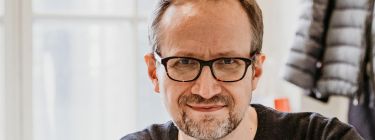
Arts Education for All: The Case of Finland
Managing Director at KAAPELI cultural centre, Helsinki
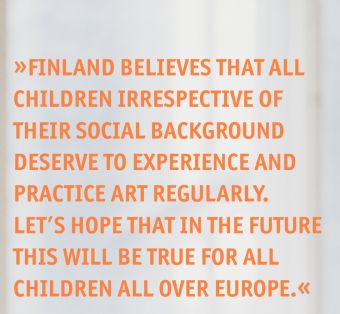
Arts Education for All: The Case of Finland
Cultural capital supports the capacities of children and young people to actively participate in society. Experiences from Finland show, however, that a generous public service provision doesn’t necessarily mean equal service offering for all. Children with a minority background and children coming from lower social classes are underrepresented among the users of the cultural programs aimed for children and young people. Recent initiatives in Helsinki, the Finnish capital, may have found a new way to tackle this challenge.
A national program for Arts education
Finland was named the happiest country in the world in 2021 by the UN Sustainable Development Solutions Network for the fourth time in a row. Alongside with the other Nordic welfare states, the country is well-known for its generous public services. These services include the public school system as well as the public healthcare system, but Finland invests heavily also in children’s arts education. And for good reason: arts and culture are known to have a positive impact on children and on young people and their future.
The national program called Basic education in the arts provides after-school-hours arts education in the local art schools in Finland. Training is goal-oriented, tied to a national curriculum and taught by professionals in the field. There are nine different art forms to choose from: architecture, circus, crafts, dance, media, music, literary art, theatre and visual arts (Luoma, 2020). Typically, education is subsidised both by the national and the local government. However, as the services are provided by private organisations, participants are required to pay to fee in order to participate.
Although, this model has resulted in admirable results—especially in the field of classical music that can be monitored both in the numbers of people playing classical music themselves and in the popularity of classical music concerts—the system hasn’t been as successful in reaching all demographic groups of the Finnish society. A study conducted by the City of Helsinki in 2016 showed that the proportion of students attending the program was much higher in wealthier social classes than in the lower ones.
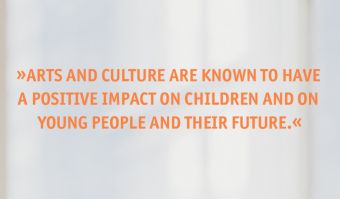
Socially disadvantaged children cannot be reached
When dividing Helsinki’s neighbourhoods in three groups according to their socio-demographic profiles, it could be concluded that participation in the arts program was most frequent where the socio-demographic profile was highest, where the services were easiest to reach and where the educational offering was highest. Participation was the lowest in the lowest socio-demographic profile and where the distance to the training places where the longest. An additional finding was that a large portion of the participants in the educational program were children and youth that had already multiple other hobbies (Vismanen et al., 2016).
Another study looking at the cultural policy and cultural diversity in the Nordic countries revealed that “people belonging to minorities, immigrants, and natives with a foreign background are mostly underrepresented both as artists, as people employed by arts institutions and organisations, and as public or audience” (Saukkonen, 2018). In addition, the challenge to reach these underrepresented groups had become more complex over time as the number of minorities had and diversified ethnically, linguistically and religiously.
Academic research and experiments
In attempting to find solutions to the situation, Finns have relied on one hand on academic research and on the other on experimentation with new ideas.
In 2016, The University of the Arts Helsinki started a six-year project called ArtsEqual. It was the largest research initiative in the field of arts ever to have taken place in Finland studying arts as public service and aiming for better equality and resulting in policy recommendations. All in all, six research groups studied the subject from various sides. The group “Basic Arts Education for All” emphasised in one of its policy briefs (Laes et al., 2018) that although arts and cultural education strengthen the cultural capital of children and young people and support their capacities to actively participate in the society, the unequal access to them could also increase the social exclusion of the children that could not participate in the program for some reason. In turn, a policy recommendation (Anttila et al. 2017) by the research group “Arts@School” suggested that public schools should be seen as “Finland’s largest cultural centres, where high-quality, diverse arts and cultural education is equally available to all.”
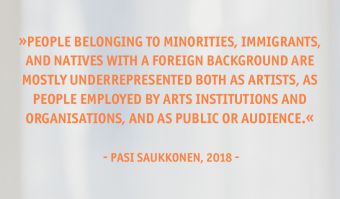
In parallel to this research work, the City of Helsinki launched a pilot phase of the Helsinki Model of arts education that brought the activities to suburbs and, thus, closer to the disadvantaged groups. Also, an arts education project called “Art Testers”, led by the Association of Finnish Children’s Cultural Centres was launched targeting teenagers.
The pilot phase of the Helsinki Model that lasted three years (2016-18), consisted of four case studies in four different suburbs around Helsinki (Lindholm & Päiviö-Häkämies, 2020). It relied on the cooperation of the cultural department of the City of Helsinki, of neighbourhood associations and of cultural institution ranging from theatres to museums and to dance and circus companies. The pilot succeeded in improving the perceived quality of life in the pilot suburbs but it taught that the local population couldn’t be reached simply by delocalising the old model of arts education. The content needed to be adapted to the setting. And yet, the most challenging groups—socially most marginalised and minorities not speaking Finnish—were still very hard to reach. This was partly because they didn’t have any previous relation to art or had even a hostile attitude toward it. City of Helsinki continues the Helsinki Model program and keeps fine-tuning it.
Art Testers integrated cultural offerings to the school curriculum initially from 2017 till 2020. Every year, it brought all Finnish 8th graders (15-year-olds) to a visit in one or two high-esteemed art attractions across Finland, such as opera or theatre performance, a concert, or an arts exhibition (Art Tester, 2021). School groups were provided with tickets and transportation to the events. Approximately 60,000 teenagers participated in the project yearly. The project ended up being so popular and successful that in the fall 2020 the Finnish Ministry of Education and Culture secured the continuation of the program.
Towards the future with “Hobi” and “Culture Kids”
Based on the research results of ArtsEqual and on the experiences gained from Helsinki Model and Art Testers, Finland is now complementing its Basic education in the arts with Hobi, the Finnish model for leisure activities (https://harrastamisensuomenmalli.fi/en/). In parallel, a new project called “Culture Kids” is being launched in Helsinki. Both initiatives aim to make their offering as accessible as possible so that truly every child could take part in the activities equally. However, the age groups targeted in each project are different.
The main objective of Hobi is to increase the wellbeing of school children by providing them a leisure activity free of charge through the school system (Hobi, 2021). However, the model is not restricted only to art-related leisure activities, and sports activities, for example, are included as well. The activities are funded by the ministry and organised by professional actors in the field of leisure in cooperation with schools. Hobi’s website started operating in August 2021.
Culture Kids’ target group, in turn, is babies, as well as their families (Culture Kids, 2021). For every child born in 2020 or after and living in Helsinki the project will designate a cultural operator that will sponsor the child’s initiation to art. The cultural sponsor is determined by the year of birth of the child. Children born in 2020 are sponsored by the Helsinki Philharmonic Orchestra, and children born in 2021 will be sponsored by theatres in Helsinki. Every year, the sponsor will invite the child and his/her family to at least two cultural events that are designed to support the child’s developmental stages and promote the well-being of their family. Culture Kids events are free of charge and the activities will continue until the child starts school. By inviting the whole age group with their family members, the program hopes to attract families that wouldn’t otherwise be prone to participate in cultural activities and by maintaining the sponsorship for six years, it aims for a lasting and living relationship between the children and art.
The Finnish example shows that even successful arts education programs have flaws and that if an arts education program has social aims, its practices need to be regularly revisited, as the demographics of our societies change. Finland believes that all children irrespective of their social background deserve to experience and practice art regularly. Let’s hope that in the future this will be true for all children all over Europe.
References
Anttila, Eeva et al. Peruskoulu: Suomen suurin kulttuurikeskus, (2017), ArtsEqual Policy recommendation 2/2017
Art Testers website (2021), https://taidetestaajat.fi/en
Culture Kids website (2021), https://kummilapset.hel.fi/brochures/en.pdf
Happiness Report 2021 (2021), https://happiness-report.s3.amazonaws.com/2021/WHR+21.pdf
Hobi – The Finnish Model for Leisure activities website (2021)
Laes, Tuulikki et al. Toimenpidesuositus Saavutettavuus ja esteettömyys taiteen perusopetuksen lähtökohtana (2018), ArtsEqual Policy recommendation 1/2018
Lindholm, Arto & Päiviö-Häkämies Laura (ed.). Helsingin malli – taidetta ja osallisuutta lähiöihin Miten pilottikauden hankkeet tavoittivat alueiden asukkaat 2016–2019?, (2020), Humanistinen ammattikorkeakoulu julkaisuja, 114.
Luoma, Tiia, TAITEEN PERUSOPETUS 2020 – Selvitys taiteen perusopetuksen järjestämisestä lukuvuonna 2019–2020, (2020), Opetushallitus, Raportit ja selvitykset 2020:4
Saukkonen, Pasi, Cultural policy and cultural diversity in the Nordic countries (2018), https://pasisaukkonen.wordpress.com/category/kulttuuripolitiikka/
Vismanen, Elina; Räsänen, Petteri, & Sariola Reetta, Taiteen perusopetuksen tila ja kehittämistarpeet Helsingissä (2016), Helsingin kulttuurikeskus
Dr. Kai Huotari
Managing Director at KAAPELI cultural centre, Helsinki
Dr. Kai Huotari (b. 1972) has 20 years of management experience in the fields of culture, academia and technology. Since 2015, Huotari has worked as Managing Director at KAAPELI the largest cultural centre in Finland. Huotari has held managerial positions also at EIT Digital, at Helsinki Institute for Information Technology HIIT, and at DocPoint – Helsinki Documentary Film Festival. In 2010-2012, Huotari worked as visiting scholar at UC Berkeley School of Information. He is a member of the board of YLE The Finnish Broadcasting Company and he serves as chairman of the board in Kunsthalle Helsinki. Huotari has a doctoral degree in economics and business administration, an M.A. degree in filmmaking, and a M.Sc. degree in computer science.
Picture © Mr. Vertti Luoma
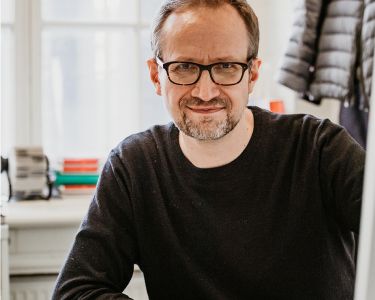
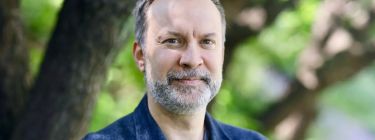
Renaissance 4.0: a vision of the cultural and creative industries
Professor of Music at Université Côte d’Azur, Nice
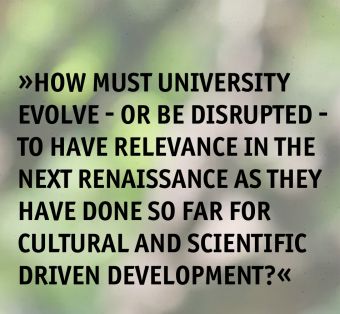
Renaissance 4.0: a vision of the cultural and creative industries
What can universities contribute to rebuilding society by a novel mix of arts and science?
Europe is currently going through an unprecedented crisis. In addition to the economic, demographic and migratory challenges that have traditionally been part of the reform of this large territory, the last decade has seen the addition of the climate challenge and the upheaval linked to the COVID-19 health crisis. By now, Europe has moved into what is known as the 4th industrial revolution, a new way of organising by combining a networked organisation and digital and collaborative development tools with the means of production in the real world. The European society, multicultural and cosmopolitan, is facing a new deal characterised by new technologies such as artificial intelligence and the virtualisation of sensory experiences. Major scientific advances coincide with new global issues. Faced with these doubts, society must question its traditional categories and rethink its objectives and its organisation.
Access to resources becomes a fundamental issue. The liberation and concentration of energies is an essential pillar of any strategy and any initiative. The collective, the local anchoring, becomes fundamental not only to reactivate the creative forces, but also to ensure to minimise their environmental impacts and to refocus the questioning of tomorrow’s production modes on the human, on the sustainable. Towards a more inclusive, resilient society. Towards a more shared academy. Towards a meeting where several platforms, several laboratories, in direct access, cohabit and share their information, and several ecosystems come together by mixing artistic and scientific perspectives. The great thinkers of the historical Renaissance had established this spirit of rupture, this capacity to embrace both the rigour of artistic thought and the formidable intuitions of scientific rationality. What does this imply for the future of universities? How must university evolve—or be disrupted—to have relevance in the Next Renaissance as they have done so far for cultural and scientific driven development?
Changing universities at the rupture of artistic and scientific perspectives
It is in this context and in order to respond to new challenges that Université Côte d’Azur has decided to undertake a profound transformation of its organisation. It has identified cross-disciplinary scientific axes to allow for multidisciplinary encounters. It is directly involved in the New Renaissance: the Arts and Sciences research program, for example, has been a driving force for the development of cross-disciplinary thinking around the history of art and the avant-garde, the practices of the performing arts, musical creation and composition, and the use of new technologies and digital technology. Thus, artistic creation is associated with the creation of new tools and new technologies, allowing the incubation of new projects, such as in music composition research, including a Cotutelle with Hamburg and the film In minimis maxima, a cross between artistic film-making and archaeological research. Innovating universities—as we are doing here at Université Côte d’Azur—is a prerequisite for an active form of creative research and transdisciplinarity.
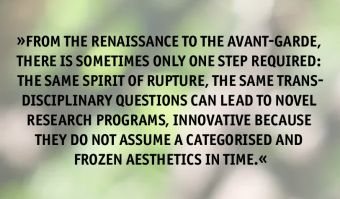
Evolving new educational forms for a Renaissance in Europe
From the Renaissance to the avant-garde, there is sometimes only one step required: the same spirit of rupture, the same transdisciplinary questions can lead to novel research programs, innovative because they do not assume a categorised and frozen aesthetics in time.There are in expressionism and futurism, in dada and fluxus, eerily premonitory resonances with the trajectories of today. “Relaunching the Avant-Garde” is one such new educational format, questioning the typical modes of production of the historical avant-garde and the new avant-garde of the 1960s.
Here the collective creation experiences of yesterday become the Creative Labs in free access, in open source, a common reflection on artistic creation and research in a world in crisis. Our daily life is now full of art and design. The number four touches all experiences: the revival 4.0, 4D cinema, 4D sound. The border between the real and the virtual, between the tangible and the digital, now immediate, needs to be probed.
Evolving organisational education structures—and what novel technologies have to do with it
The COVID-19 crisis gave birth to this grouping of researchers within Université Côte d’Azur around this simple idea: Sometimes experiences in extended reality (XR) require the implementation of new technologies, new methodologies, so we move from the interdisciplinary to the transdisciplinary: to propose the vision of a common project, a common work in order to consider new experiences of existence. Probing the continuum between the real and the virtual, these forms of immersivity require a high level of expertise, transdisciplinary, and its exploration using innovative technological platforms AND Université Côte d’Azur has set up a novel research centre dedicated to extended reality (XR2C2). This cooperative dynamic questions narrative as well as performativity, the formalisation of uses, curatorial practices as well as the effects of training and rehabilitation.
Another innovative mix of science and arts driven by new technologies is the Virtual Reality for Gender Equality in Education (RevEGO) project. It works against gender inequality and discrimination in digital domains and in particular in the field of education and career guidance. The Project Perception Toolbox for Virtual Reality (INRIA) allows the creation of visual perception experiences in virtual reality, with a research purpose but also a reading aid for people with low vision.
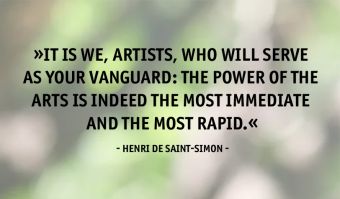
Experiences of Université Côte d’Azur teach us that education and research starts local, and they led to society matters.
Such radical intersections of artistic and scientific experiences—as at U7+ Alliance of world universities and Université Côte d’Azur—should lead the whole of society to immerse itself in a reflection on otherness, on a certain form—in the aesthetic sense—of vision of the world, so that art can, at times, revive the place it once occupied in the Camerata Fiorentina. Or as it was described in Henri de Saint-Simon’s The Artist, the Scientist, the Industrialist (1824), „It is we, artists, who will serve as your vanguard: the power of the arts is indeed the most immediate and the most rapid. We have weapons of all kinds: when we want to spread new ideas among men, we inscribe them on marble or on canvas; we popularize them by poetry and song; we employ alternately the lyre or the galoubet, the ode or the song, the history or the novel; the dramatic stage is open to us.”
Damien Ehrhardt and Hélène Fleury recall the extent to which the great figure of Alexander von Humboldt prefigured the current challenges of history. By combining science and aesthetics, by associating observation, artistic fascination and understanding of the world, Humboldt was one of the great operators of transdisciplinarity, of the connection between the fields of knowledge, learning and art, by reviving the spirit of humanism. The place of science, art and technology in our societies is fundamental, and even more so when it is aimed at education. In a digital, globalised environment, thinking about this next Renaissance also means, paradoxically, giving meaning to local energies, to the forces that combine in proximity and in education, mutual aid, and local culture.
Today’s organisational challenge to empower novel creations in a Next Renaissance is that a global university such as Université Côte d’Azur must, first of all, interact at the level of local authorities to federate the players, to develop techniques of knowledge and education in direct access, so that everyone can access the data and the tools to transform tomorrow’s society. It is to all of these challenges that we are responding. To quote Saint-Simon again, „the power of imagination is incalculable when it takes off in a direction of public good.”
MORE INFO ON UNIVERSITÉ CÔTE D'AZUR
Université Côte d’Azur is an experimental, research-intensive multidisciplinary university. It was created out of the desire of research centers and major educational establishments to build a university with exceptional academic potential that is creative and humanistic. It is developing a strategy based on both excellence and interdisciplinarity, which places it in the top 3% of the world’s universities and makes it one of France’s 10 major research-intensive universities (IDEX label).
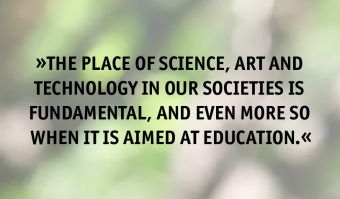
Jean-François Trubert
Professor of Music at Université Côte d’Azur, Nice
Jean-François Trubert’s work focuses on the creative process of music, especially in contemporary opera and new music theater, but also in multimedia and digital environments, with an emphasis on the question of gesture and its relationship to the aesthetic form of the works. His research include the works of Kurt Weill, Luciano Berio, Mauricio Kagel, and Georges Aperghis. Former Dean of the Graduate School of Arts and Humanities “CREATES”, he is a member of the Transdisciplinary Center in Epistemology of Litterature and performing Arts (CTEL), and founded a interdisciminary Center for Research and Creativity in Extended Reality at Université Côte d’Azur. He is co-director of the collection Arts, Cultures, Pouvoirs at Presses Universitaires de Savoie-Mont Blanc, he is involved in research projects founded by the National Research Agency and European Council Europe Creative. He has published in the Brecht-Yearbook, the journals filigrane, Dissonance and in the Contemporary Music Review, as well as in collective works.
Picture: © C.A. MACARRI université d’Azur
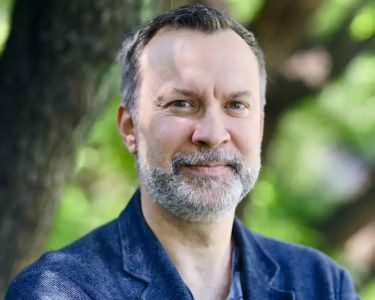

For the word and freedom, one industry stands for free discourse
Represents interests and is central service provider of the German book industry

For the word and freedom, one industry stands for free discourse
This text is a joint contribution of several colleagues at the Börsenvereinsgruppe.
„A conversation presupposes that the other person might be right.“ With this statement, the philosopher Hans Georg Gadamer formulated the basis for respectful interaction. It is a basic prerequisite for a lively culture of debate and indispensable for a democratic opinion-forming process. The book industry has set itself the task of promoting this process and making younger generations aware of its importance. Recently, the discussion about the stand of a right-wing publisher at the Frankfurt Book Fair 2021 showed that a constructive exchange of opinions cannot be taken for granted and that the current climate of debate in our society is highly heated.
This debate was triggered by the call for a boycott by the black German author Jasmina Kuhnke, who stated that she did not feel safe due to previous racist threats caused by the presence of a publisher from the right-wing end of the spectrum at the Frankfurt Book Fair.
She cancelled her participation in an event at the book fair and called on other participants to do the same. Some authors followed her example; others demanded to participate in the Frankfurt Book Fair for this very reason: in order to show their face there and stand up for diversity and against racism. While the traditional media such as print, TV and radio took a differentiated view of the issue, a wave of indignation broke out on social media. On the one hand, this helped that right-wing publishing house to receive a great deal of attention, whose content would otherwise hardly have been disseminated at the book fair. On the other hand, it overlapped the reporting and discussion of other topics at the book fair, leaving little room for a diverse range of topics.
It also became clear during those days in October 2021 that the limits of freedom of expression that apply to our society must be constantly re-discussed.
The Corona crisis also reinforced existing divisive tendencies in our society. During the pandemic, society’s ability to discourse was under particularly high pressure. Expressions of opinion that, under certain circumstances, deviated from the unanimous majority view or ran counter to a vocal minority provoked an aggressive backlash. Riots at demonstrations and physical attacks on reporters in public spaces were just as alarming as the hate and incitement to violence on social media. Germany moved down two places in the 2021 press freedom ranking.


TOGETHER FOR FREEDOM OF EXPRESSION WORLDWIDE
The Börsenverein Group, which consists of the Börsenverein des Deutschen Buchhandels and its subsidiaries Frankfurter Buchmesse GmbH, MVB and Mediacampus, sees as one of its core tasks to defend the freedom of the word as an elementary human right and to guarantee freedom of expression as a prerequisite for freedom of publication and literary diversity. To allow different opinions and currents as long as they remain within the bounds of the law, and to argue one’s own values, is, in the view of the Börsenverein, the right way forward in a pluralistic and democratic society.
At the same time, freedom of expression is under threat from the state in many countries. In an increasing number of countries around the world—be it Saudi Arabia, Turkey, China, Russia, Belarus, Egypt or Vietnam—people are persecuted, imprisoned or murdered simply because they criticise the actions of the government. But in Poland and Hungary, countries in the European Union, free reporting is also restricted.
Publishers and bookstores in Germany stand up for persecuted authors, publishers and booksellers worldwide. The Börsenverein sees it as its task to draw attention to the fate of persecuted cultural workers and to call on the political leaders in Berlin and Brussels to consistently stand up for freedom of expression.
#MehrAlsMeineMeinung
/ #MoreThanMyOpinion
In May 2021, „Freedom of Expression Week“ was held for the first time. Especially in times of pandemic, the Börsenverein felt the time was ripe for a deeper examination of freedom of speech. Together with partners, the association organised a major celebration from May 3 to 10 for the freedom of the word, the value on which everything the book industry stands for is based. Under the motto „More than my opinion,“ around 40 partner organisations took part, including Amnesty International, Reporters without Borders, the Goethe Institute and Eintracht Frankfurt, along with many prominent supporters such as Wolfgang Niedecken, Susanne Fröhlich, Jagoda Marinic and Michel Friedman. The media response from radio to television to print was great. There were also many reactions on social media, most of them very positive.
Central to this week—which will now take place annually and be expanded internationally—was a dialog about the prerequisites and limits of a free and diverse society. The content of the Freedom of Expression Week was based on the Charter of Freedom of Expression. Signing the Charter is a commitment to recognise the eleven principles set out in it, to act in accordance with them and to carry them into one’s own environment and network.
As special places of cultural encounter and social exchange, bookstores moved into the public eye. They positioned themselves as places of freedom of expression: „We booksellers can do a lot to improve the culture of debate in our stores: by making the spectrum of opinions on controversial topics visible in our product range or by organising events that explicitly invite controversial discussions. This is how bookstores can become places of freedom of opinion,“ says Michael Lemling, managing director of the Lehmkuhl bookstore in Munich and spokesman for the Börsenverein’s freedom of opinion interest group.
„We want to promote critical debate and differentiated opinion-forming that uses the power of arguments rather than polemics,“ says Alexander Skipis, Chief Executive Officer of the Börsenverein des Deutschen Buchhandels. “This is the hour of civil society. Let’s work together to ensure that all people can express their opinions freely and without fear, and in such a way that a constructive exchange of ideas emerges from it that moves us forward as a society. Freedom of expression is the driving force of our democracy. Thanks to it, all citizens can have their say in addressing the problems of our time. But we don’t have freedom of expression per se; we have to make use of it every day.“
BOOKS THAT EXPLAIN THE WORLD
Another component of the Group-wide commitment to free discourse is the German Nonfiction Book Prize, which was also awarded for the first time in 2021. The Stiftung Buchkultur und Leseförderung (Book Culture and Reading Promotion Foundation) of the Börsenverein awards this prize to the nonfiction book of the year (Deutsche Sachbuchpreis). The prize is awarded for outstanding nonfiction books written in German that provide impetus for social debate.
The judging criteria are the relevance of the topic, the narrative power of the text, the way it is presented in generally understandable language, and the quality of the research. The nonfiction prize, worth a total of 42,500 Euros, will be awarded at a ceremony in Berlin. It is intended to raise awareness of nonfiction books as a basis for conveying knowledge, forming well-founded opinions and providing impetus for public discourse.
“I can’t imagine a world without books that explain the world. Nonfiction books do just that, and sometimes they even change the world, or at least make it a little better,“ says Margit Ketterle, publishing director of nonfiction at Droemer Knaur, a member of the German Nonfiction Book Award Academy.
Equally important in this context is the role of reading promotion. The group’s reading promotion activities, such as the German Book Trade’s reading competition, the Book Kindergarten Seal of Approval, and campaigns for World Book Day, focus on communicating the joy of reading and awakening reading motivation.
Reading is a basic prerequisite for education, personal development, professional success and creative participation in society. Nowadays, this social participation is more important than ever if we, as individual members of our society, are to actively combat social division and be involved in social debates throughout our lives. In 2021, Stiftung Lesen and the Börsenverein therefore initiated the National Reading Pact, which aims to improve reading promotion in Germany with more than 150 partners. The kick-off event was the National Reading Summit on March 3, 2021.
Conclusion
The Börsenverein des Deutschen Buchhandels (German Publishers and Booksellers Association) and its business enterprises are united in their support for a culture of open debate and create offerings to strengthen the freedom of expression. In doing so, they make a significant contribution to social participation. After all, in order to emerge stronger from a crisis—in line with the Renaissance 4.0 and to enter a new era together with innovative ideas—the Börsenverein group believes that responsible citizens and readers are needed who identify reliable sources, recognise fake news as such, and want to live in an open culture of debate. Everyone should have the opportunity to play a part in tackling our collective challenges in a goal-oriented way. For the word and freedom.

Börsenvereinsgruppe Germany
The Börsenvereinsgruppe represents the interests and is the central service provider of the German book industry. From political work and cultural projects to trade fair organisation, training and continuing education, publishing and technology services, it bundles service and educational offerings for the book and media industry. The group consists of the Börsenverein des Deutschen Buchhandels (German Publishers & Booksellers Association) and its three business subsidiaries:
The Frankfurt Book Fair annually organises the world’s largest book fair in Frankfurt am Main as well as international conferences and represents the German book industry around the globe with joint stands. MVB, a technology and information provider, enables publishers and bookstores in Germany and abroad to market their titles successfully and efficiently with its central platforms based on international metadata standards. mediacampus frankfurt is the central training and continuing education provider for specialists and managers in the book and media industry.
Picture: © Rainer Rüffer

